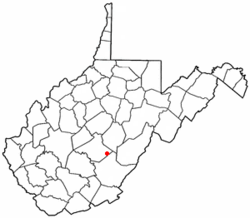Richwood, West Virginia
| Richwood, West Virginia | |
|---|---|
| City | |
 |
|
| Nickname(s): The Ramp Capital of the World," "The Gateway to the Monongahela National Forest |
|
| Motto: The City Merry on the Banks of the Cherry. | |
 Location of Richwood, West Virginia |
|
| Coordinates: 38°13′25″N 80°32′12″W / 38.22361°N 80.53667°WCoordinates: 38°13′25″N 80°32′12″W / 38.22361°N 80.53667°W | |
| Country | United States |
| State | West Virginia |
| County | Nicholas |
| Government | |
| • Mayor | Bob Henry Baber |
| Area | |
| • Total | 1.67 sq mi (4.33 km2) |
| • Land | 1.61 sq mi (4.17 km2) |
| • Water | 0.06 sq mi (0.16 km2) 3.59% |
| Elevation | 2,205 ft (672 m) |
| Population (2010) | |
| • Total | 2,051 |
| • Estimate (2012) | 2,039 |
| • Density | 1,273.9/sq mi (491.9/km2) |
| Time zone | EST (UTC-5) |
| • Summer (DST) | EDT (UTC-4) |
| ZIP code | 26261 |
| Area code(s) | 304, 681 |
| FIPS code | 54-68116 |
| GNIS feature ID | 1555475 |
| Website | richwoodwv.com |
Richwood is a city in Nicholas County, West Virginia, United States. In 2010, the census showed Richwood with a population of 2,051. During the 19th and early 20th century Richwood was a booming coal and lumber town. Richwood has had a very rich history, most notable was the formation of the Cherry River Navy. The Cherry River Navy was used to draw attentions to important issues around the community.The Navy had some A-list members that included Babe Ruth, President Hoover, President Truman, and President Eisenhower. Richwood has also became known statewide as the "Ramp Capital of the World". Each year, in April, the city hosts a large festival that draws visitors from around the country.
The area surrounding the forks of the Cherry River has been populated since the late 18th century CE.
During the 19th century, the area was a sparsely settled semi-wilderness of homesteads and subsistence farms. This changed in 1898 when a railroad was extended into the area, then known as Cherry Tree Bottoms. In 1901, the town was incorporated with its present name, a nod to the abundant hardwood forests in the area. Soon the area possessed a large sawmill and the world's largest clothespin factory. Coal mine closures, however, crippled Richwood's economy in the 1970s and 1980s.
The town was once home to several large businesses and industries. In addition to the sawmill and the clothespin factory, there were other factories that produced wood-based products such as axe-handles and paper. Coal also came into the industry picture during Richwood's boom-era during pre-Depression years. During this time the city's population neared 10,000 citizens. Banking was also a white collar industry that succeeded in the city with the large companies investing into the city's financial corporations. Once the large factories closed or relocated, many of the people followed. The final hit was when the coal industry took a downward turn and most of the local coal mines ceased operation. This was combined with a deep mining disaster when one of the local mines collapsed.
...
Wikipedia
